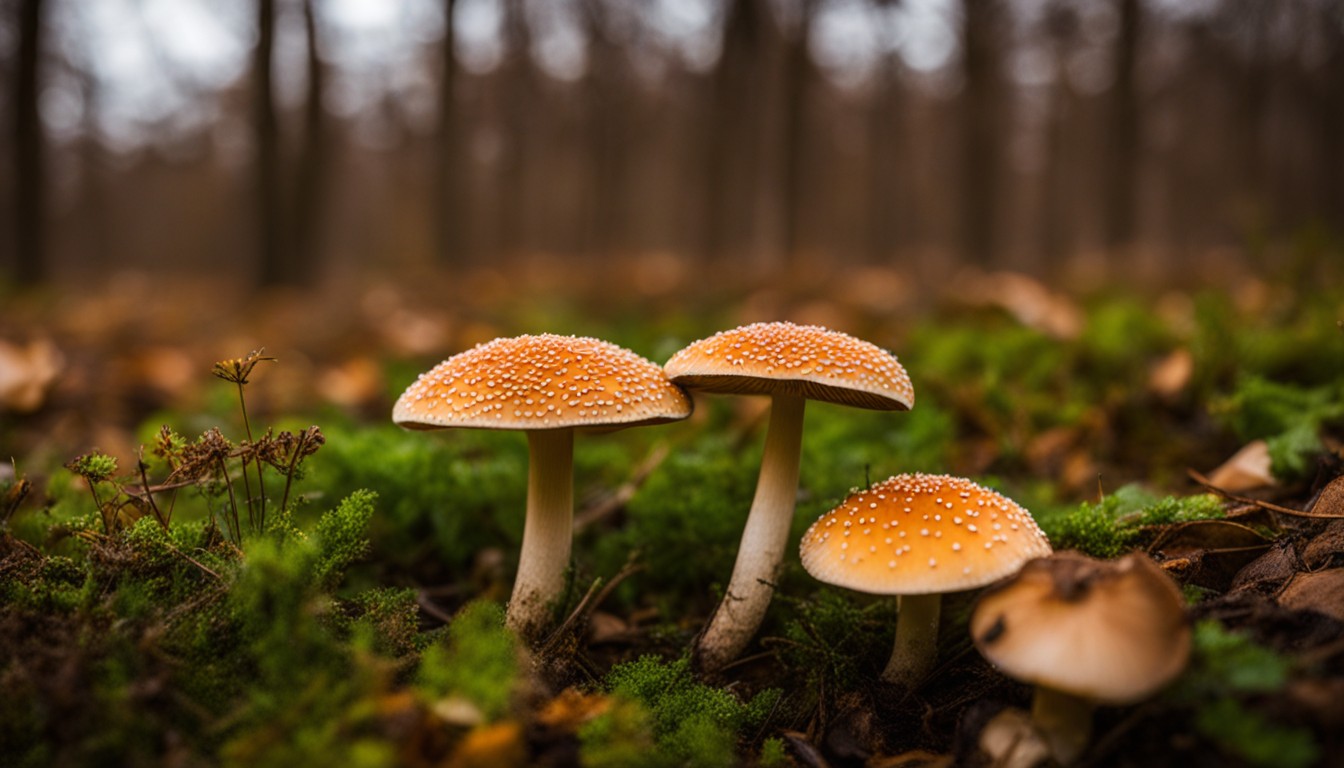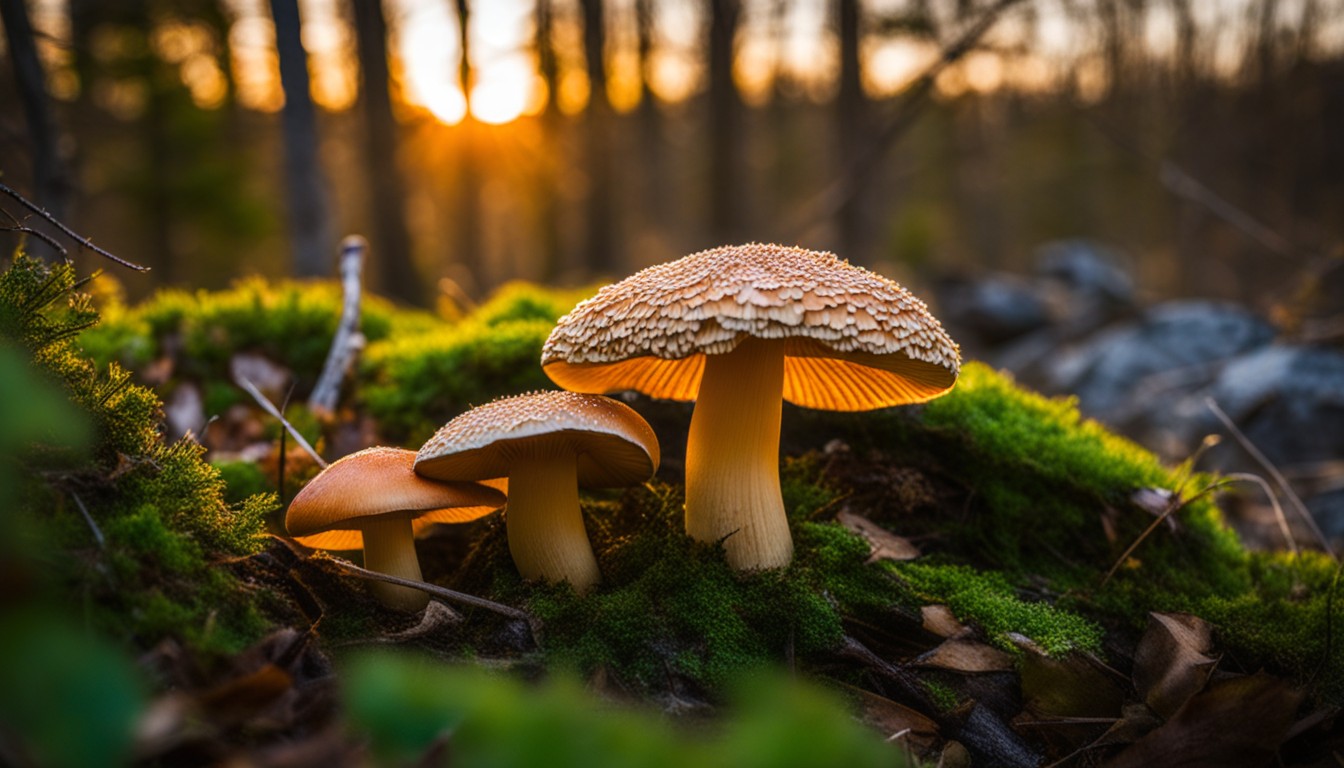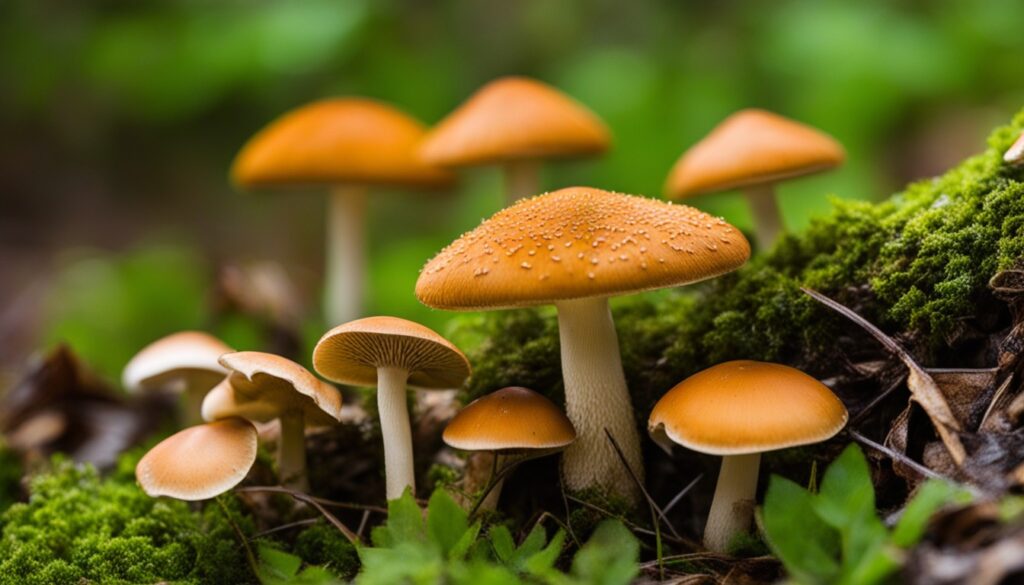Are you a nature enthusiast in Rhode Island? Discover the fascinating world of mushrooms in the Ocean State with our comprehensive guide. From identifying common species to exploring the best mushroom hunting spots, this article will equip you with the knowledge you need to embark on your own mycological adventure. Whether you’re a beginner or an experienced forager, dive into the enchanting realm of mushrooms and uncover the hidden treasures that lie beneath the forest canopy. Join us as we unravel the secrets of Rhode Island’s fungi kingdom and gain a deeper appreciation for the wonders of nature.
Types of Mushrooms in Rhode Island
Rhode Island, with its diverse ecosystems, is home to a rich variety of fungi – from the meaty and edible Boletus edulis to the hallucinogenic and poisonous Amanita muscaria. Each variant has unique identifiers, like the dry, pitted top of the Leccinum scabrum or the distinctive honeycomb pattern of the Morchella esculenta.
Rhode Island’s landscapes’ complexity directly mirrors the diversity of its fungi, hosting species from edible Boletus edulis to mysterious ‘Jack-O-Lantern’ mushrooms.
Interestingly, the mushroom biodiversity in the Ocean State mirrors the complexity of its landscapes. You’ll find the captivatingly mysterious Omphalotus olearius, also known as the ‘Jack-O-Lantern’ mushroom in the leaf litter of hardwood forests, while the white-capped Agaricus bisporus commonly resides in grassy pastures.
Edible Mushrooms
Rhode Island boasts a diverse array of edible mushroom species, which can be distinguished from their inedible counterparts using certain criteria. Along with their unique flavors, these local fungi offer a range of culinary and medicinal benefits.
- An awareness of cap shape, stem structure, spore color, and habitat can significantly aid in correctly identifying edible mushrooms
- Wild oyster mushrooms, a common find, are known for their distinct, savory flavor and immune-boosting properties
- Maitake or ‘hen of the woods’ mushrooms grow around oak trees and offer significant health benefits, including cholesterol-lowering effects
- Porcini mushrooms, prized in Italian cuisine for their rich flavor, are commonly found in pine and beech forested areas of Rhode Island
- Look out for medicinal reishi mushrooms, typically growing on dead or dying hardwood trees
- Morel mushrooms are a spring favorite forage, valued for their unmatched taste and high vitamin D content
Poisonous Mushrooms
In Rhode Island, the beautiful scenery often hides a danger beneath its shadow: poisonous mushrooms. The region hosts a number of toxic fungi that can cause severe harm if ingested.
- The death cap (Amanita phalloides), notorious for its lethal toxicity.
- False morels (Gyromitra esculenta), capable of causing nausea, dizziness, or even more severe effects.
- The destroying angel (Amanita bisporigera), a deadly mushroom with toxins that can cause catastrophic damage to the liver and kidneys.
- Deadly galerina (Galerina marginata), a poisonous fungus characterized by its brown cap, which holds deadly amatoxins.
Identifying Local Mushrooms

A profound grasp of mushroom identification is vital for any forager in Rhode Island. This stems not only from the need to differentiate edible from poisonous varieties but also to enrich your overall foraging experience.
Recognizing local mushrooms entails careful observation of their key features, including cap shape, gill attachment, spore color, and habitat. It’s this deep comprehension that enhances safety and ensures a rewarding foraging adventure in Rhode Island.
Mushroom Foraging Tips
For an enjoyable and successful mushroom foraging experience in Rhode Island, understanding the best times, locations, and practices is crucial. These elements not only maximize the harvest but also ensure your foraging is safe and ethical.
- Early morning or late evening proves an ideal time for mushroom foraging, as the temperature is cooler and mushrooms are less likely to have dried out.
- Moist and humid days, especially after a heavy rainfall, are perfect. This is when most mushrooms pop up.
- Wooded areas, such as state parks and nature reserves in Rhode Island, offer a rich variety of fungi.
- Consider bringing a local mushroom identification guidebook or app to easily distinguish edible mushrooms from toxic look-alikes.
- Ensure to cut mushrooms at the stem rather than uprooting them for the sake of preserving their habitat.
- Implore the practice of ‘take only pictures, leave only footprints.’ Never over-harvest; leave some mushrooms for wildlife and to guarantee future growth.
- Remember to dress appropriately with sturdy shoes and long pants to protect against ticks, poison ivy, and other potential hazards.
Common Identifiable Mushrooms
Exploring the lush woodlands of Rhode Island, you will frequently find various mushroom species, each with its own unique characteristics and habitat preferences. Recognizing these traits becomes a valuable skill in identifying them.
- Chanterelles, known for their trumpet-like shape and golden-yellow hue, often found in hardwood forests alongside moss and leaf litter.
- Morels, identifiable by their distinctive honeycomb-like cap and preference for disturbed ground like burn areas and old apple orchards.
- Death Caps, distinguishable by their pale yellow-green caps, skirted stems and preference for oak tree roots. Always avoid consumption as they’re highly poisonous.
- Turkey Tail, seen on the sides of logs and tree stumps, distinguished by their fan-like shape and colorful concentric circles.
- Fly Agaric, often seen in fairytales, identified by their vibrant red caps with white spots. Highly toxic if consumed raw and should be avoided.
Best Places to Find Mushrooms in Rhode Island

Rhode Island is teeming with mycological wonders in places such as state parks or nature reserves. These, along with numerous wooded areas and forest trails, provide fertile grounds for a diversity of mushrooms.
A unique pursuit for mushroom enthusiasts can be found in Rhode Island’s lesser-known locations. These often-overlooked spots present an opportunity to unearth rare species and enhance the foraging experience.
State Parks and Nature Reserves
Rhode Island, rich in diverse landscapes, boasts an incredible variety of mushroom species within its state parks and nature reserves. The local biota is a haven for fungi enthusiasts with a myriad of edible and poisonous mushrooms thriving in specific ecosystems.
- The Blackstone River Valley State Park is a haven for mushroom foragers, famed for its high diversity of fungi, especially after rainfall.
- Arcadia Management Area, covering a vast 14,000 acres of forestland, beckons mushroom hunters with its numerous species of fungi scattered across the forest floor.
- Lincoln Woods State Park, notable for its plethora of mushrooms, serves as a popular spot for nature-lovers and fungi explorers.
- Browning Mill Pond Area in Arcadia Management does not disappoint with its rich fungal flora, especially favorable for novices in mushroom foraging.
- Beavertail State Park, known for its scenic beauty, is a treasure trove of various mushroom species, depending on the season.
Wooded Areas and Forest Trails
A tapestry of diverse fungi color Rhode Island’s wooded landscapes, a testament to the region’s ecological richness. The mossy floors of local woodlands are adorned with edible treasures like Morels and Chanterelles, amidst the cautionary hues of Fly Agarics.
Navigating through Rhode Island’s forest trails allows foragers to witness the seasonal spectacle of local fungi. Amidst fallen leaves and decaying logs, one might discover varieties from the abundant Boletes to the elusive Hen of the Woods, each contributing to the state’s mycological diversity.
Seasonal Variations and Mushroom Hunting
In Rhode Island, patterns of fungi distribution and growth are notably influenced by seasonal transitions. The arrival of spring, summer, or fall often signals distinctive mushroom life cycles and prompts shifts in diverse mushroom species’ appearances.
The interplay between Rhode Island’s enthralling mushroom life cycles and the state’s unique climate patterns is indeed captivating. Rigorous variations in temperature, precipitation, and humidity amplify mushroom growth and diversification throughout the year.
Spring Mushrooms
The arrival of spring in Rhode Island heralds the emergence of prized Morels—often considered the stars of the season’s mushroom spectrum. Their distinctive honeycomb-like caps make identification relatively straightforward, even for novice foragers.
Rhode Island’s spring climate, featuring moderate rainfall and gradual warming, perfects the conditions for mushroom growth. This season’s humidity and temperature pave the path for the growth of not only Morels but also other remarkable funguses.
Notably, climate change has begun to rewrite these unspoken seasonal narratives of mushroom foraging. Unexpected temperature fluctuations and shifting rainfall patterns have introduced considerable uncertainty in the growth and availability of these spring delights.
Summer Mushrooms
Rhode Island’s summer bestows us with the delectable Chanterelles, a gift from nature, identified by their trumpet-like shape and light, buttery taste.
More than an occurrence, the boom of summer mushrooms reveals a symbiotic relationship; the fungi supply nutrients to their host plants, fostering a rich and flourishing ecosystem.
Fall Mushrooms
Fall in Rhode Island brings the magnificent Matsutake mushroom, a prized delicacy with its distinctive spicy aroma. These edibles often appear under pine trees, presenting a real treat for local fungi enthusiasts.
Before embarking on a fall mushroom foraging trip in Rhode Island, ensure you identify mushrooms accurately. Certain species such as deadly Galerina may resemble harmless varieties, hence caution and knowledge are paramount to ensure a safe experience.
Safety Measures When Foraging
In the safety-driven world of mushroom foraging in Rhode Island, a ‘spore print’ is essential. This simple measure provides a reliable preliminary identification, effectively reducing the risk of exposure to toxic fungi.
With the rise of technology, Rhode Island mushroom foragers stand better chances at safe exploration. Innovative solutions like dedicated mobile apps and online communities offer instant access to mushroom identification databases, thus ensuring increased safety while foraging.
Toxic Look-Alikes
Rhode Island is home to a number of toxic mushrooms that cunningly mimic their edible counterparts. This includes the deadly Destroying Angel mushroom which bears uncanny resemblance to the edible Meadow Mushroom, and the dangerously deceptive Death Cap which mirrors the common Parasol mushroom.
Contact with these toxic look-alikes can have severe medical consequences. The Death Cap, for instance, initially causes gastrointestinal upset, followed by liver and kidney damage. The Destroying Angel, equally treacherous, triggers severe abdominal pain, vomiting, and can ultimately lead to renal and hepatic failure.
In order to safeguard against these toxic look-alikes, a thorough understanding of their unique identifiers is crucial. Engaging with local mycological societies or learning from experienced mushroom foragers can significantly boost an individual’s ability to safely distinguish between these dangerous doppelgangers and their edible siblings.
Proper Mushroom Handling
Trimming, de-spiking, and cleaning are just a few steps in the comprehensive guide for handling Rhode Island mushrooms. Weathered brushes can be used to gently wipe any dirt off the cap and stalk, while a sharp knife is effective for removing any tainted parts.
Adherence to proper mushroom processing norms is critical in Rhode Island to ensure food safety. Incorrectly handling mushrooms can potentially harbor harmful pathogens, making it critical to follow these guidelines to minimize risks associated with ingestion of harmful bacteria.
Culinary Uses of Rhode Island Mushrooms

Delving into the culinary world of Rhode Island, it’s hard to overlook the role local mushrooms play in signature dishes. From the sublime Chanterelle Risotto to the earthy Morel-laden chowder, these fungi are celebrated culinary stars.
In high-end restaurants around the globe, Rhode Island’s gourmet mushrooms are coveted ingredients. These fungi, with their distinctive, chewy textures, and rich flavors, amplify the taste introduced in culinary creations, marking Rhode Island mushrooms a triumph in the global gastronomic landscape.
Recipes Using Local Mushrooms
Looking to create a unique, distinctive flavor for your meals? Rhode Island’s local mushrooms offer an expansive recipe portfolio. With their rich, earthy tones, they blend beautifully into risottos, stir-fries, and stews, giving meals a wonderful rustic charm.
Think outside the box – use Rhode Island mushrooms to bring class and novelty to your kitchen. Create inventive dishes using their unique flavors. Whether stir-fried with herbed butter or stuffed with spiced meat, these local fungi will surely update your culinary repertoire.
Preserving and Storing Mushrooms
Rhode Island’s lush woodland fungi not only present an eclectic flavor palette, but also require specialized preservation techniques. Drying is a favored method, it effectively retains the mushroom’s natural taste while extending its shelf life. Specialty dehydrators or traditional oven methods could serve the purpose.
Gourmet adventures extending beyond the foraging season may consider freezing as a suitable method. Flash-freezing freshly picked mushrooms gives them a firm texture and maintains their natural aroma. Subsequent thawing follows no rush, retaining the essence for later culinary exploration.
Caning or pickling provides a different perspective to mushroom preservation. The acidic environment of the pickle jar adds a tangy touch to the mushroom’s original flavor, while canning entraps the freshness within. Rhode Island mushrooms packed in brine or vinegar present a unique delicacy.
Despite the method, environment control during mushroom storage is non-negotiable. Cool, dry, and dark places maintain preservation quality, ensuring that Rhode Island mushrooms last longer while keeping their flavor intact. Regular checks for signs of spoilage are essential.
Packaging plays an instrumental role in preventing unwanted moisture or contaminants. Airtight containers or plastic bags are widely used for dried or frozen mushrooms. Meanwhile, glass jars suit pickled or canned ones perfectly. Always label the containers with the date for effective rotation and use within the recommended duration.
Frequently Asked Questions
What are some common types of mushrooms found in Rhode Island?
Rhode Island is home to a variety of mushrooms, including the Chanterelle, the Hen of the Woods, the Chicken of the Woods, and the Scarlet Elf Cup. These mushrooms can be found in various habitats such as forests, wetlands, and grassy areas.
Where can I go mushroom hunting in Rhode Island?
There are several parks and nature reserves in Rhode Island that are great for mushroom hunting, such as Lincoln Woods State Park, Arcadia Management Area, and Burlingame State Park. These areas offer diverse ecosystems and provide ample opportunities to discover different mushroom species.
How can I identify mushrooms in Rhode Island?
Identifying mushrooms can be challenging but rewarding. It’s important to study their physical characteristics, such as shape, color, texture, and the presence of gills, pores, or spines. Additionally, using field guides, online resources, and joining local mushroom foraging groups can provide valuable knowledge and resources for accurate identification.
Are there any poisonous mushrooms in Rhode Island?
Yes, there are poisonous mushrooms in Rhode Island, such as the Death Cap, the Destroying Angel, and the False Morel. It is crucial to have expert knowledge or consult with an experienced mycologist before consuming any wild mushrooms. Remember, it is always better to be safe than sorry when it comes to mushroom foraging.
Can I forage mushrooms for personal consumption in Rhode Island?
It is legal to forage mushrooms for personal consumption in Rhode Island, as long as it is done responsibly and not for commercial purposes. However, it’s important to respect private property rights and obtain permission from landowners before foraging. Additionally, check with local regulations and obtain any necessary permits if required.
What precautions should I take when mushroom foraging in Rhode Island?
Always be cautious when foraging for mushrooms. Only collect mushrooms that you can positively identify, avoid areas with pollution or chemical contamination, and be mindful of the environment by not damaging the surrounding vegetation or ecosystem. It’s also a good practice to carry a mushroom identification guide, a basket, and a knife for proper collection.
Are there any guided mushroom foraging tours in Rhode Island?
Yes, there are guided mushroom foraging tours available in Rhode Island. These tours are often led by experienced foragers or mycologists who can provide valuable insights, teach you about mushroom identification and safety, and ensure a safe and educational experience. Participating in these tours is a great way to enhance your knowledge and skills in mushroom foraging.
Can I cook and eat the mushrooms I find in Rhode Island?
Yes, you can cook and eat the mushrooms you find in Rhode Island, but exercise extreme caution and proper identification. If you are unsure about the edibility of a mushroom, it is always best to err on the side of caution and consult with an expert before consuming them. Remember to thoroughly cook mushrooms before consuming to eliminate any potential toxins or harmful substances.
Is it legal to sell wild mushrooms in Rhode Island?
Selling wild mushrooms in Rhode Island requires a permit and compliance with regulations. It is recommended to check with local authorities and obtain the necessary permits before selling any wild mushrooms. Selling mushrooms without proper authorization can result in fines or legal consequences.
Can I replant mushrooms in Rhode Island?
Mushrooms are the fruiting bodies of underground mycelium, and it is not possible to directly replant mushrooms. However, you can create a favorable environment for the growth of mycelium by providing suitable conditions, such as proper moisture, temperature, and substrates like wood or compost. By promoting the growth of mycelium, you can increase the chances of mushrooms naturally appearing in your desired area.
Are there any mushroom festivals or events in Rhode Island?
Rhode Island hosts various mushroom festivals and events throughout the year, where you can learn more about mushrooms, attend workshops, and explore different culinary delights featuring these fascinating fungi. From mushroom identification classes to cooking demonstrations, these events offer opportunities to connect with fellow mushroom enthusiasts and expand your knowledge of the fungal kingdom. Keep an eye on local event listings, mushroom foraging groups, and regional mycological societies for upcoming festivals and gatherings.
Conclusion
With the plethora of mushrooms in Rhode Island, expanding your foraging knowledge is key to a bountiful hunt. The mushroom diversity here is indeed impressive, paving the way for a lucrative journey into the world of fungi.
Reflecting on the richness of Rhode Island’s mushroom diversity, foraging in this region promises an all-encompassing wildlife experience. It’s an opportunity to explore, learn, and thrive while maintaining respect for nature’s offerings.
- Learn to distinguish edible from poisonous mushrooms
- Understand the seasonal variations of mushrooms
- Find the best spots to discover mushrooms
- Familiarize yourself with ways to handle mushrooms safely
- Discover culinary uses of local mushrooms and preservation techniques

